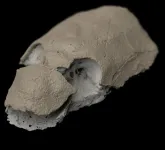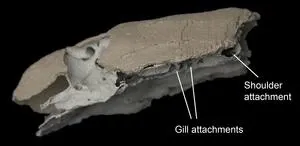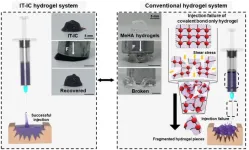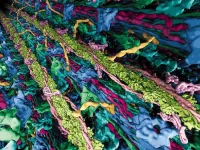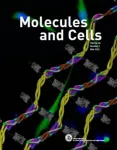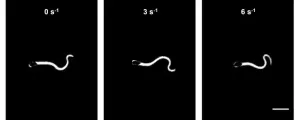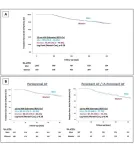(Press-News.org) A new analysis of the bones and muscles in ancient fish gives new clues about how the shoulder evolved in animals – including us.
The shoulder girdle – the configuration of bones and muscles that in humans support the movement of the arms – is a classic example of an evolutionary ‘novelty’. This is where a new anatomical feature appears without any obvious precursors; where there is no smoking gun of which feature clearly led to another.
The new research, which draws together a range of evolutionary investigation techniques including fossils, developmental biology, and comparative anatomy, suggests a new way of looking at how major anatomical features like shoulders evolved.
The results of the study, led by Imperial College London’s Dr Martin Brazeau and Natural History Museum researchers, are published today in Nature.
One theory of the shoulder’s origin is that it was part of how fins formed in pairs on either side of the fish body, the evolution of which allowed fish more swimming control and eventually spurred the move from water to land. The ‘gill-arch’ hypothesis suggests that these fins evolved from the bony ‘loops’ that support the gills, which also formed the shoulder. However, it has been difficult to gather any evidence for this hypothesis, as the features are rarely preserved in fossils.
A different theory of how the fins formed, the ‘fin-fold’ hypothesis, suggests the precursors of the paired fins instead evolved out of a line of muscle on the flanks of the fish. This theory has gained a lot of supportive evidence in the 150 years since both were proposed, but it cannot explain how the associated shoulder girdle evolved.
Now, by reanalysing an ancient fossil fish skull from soon after the shoulder girdle emerged, alongside other lines of evidence, the team suggest the truth may lie in a modified version of the gill-arch hypothesis that reconciles it with the fin-fold hypothesis.
The fossil the team looked at is a placoderm, of the species Kolymaspis sibirica, which lived around 407 million years ago and was among earliest jaw-bearing fishes. The fossil has a well-preserved brain case – the hard inner parts of the skull that record imprints and other features of the brain.
Dr Brazeau realised that despite the poor or absent preservation of the gill arches in such fossils, evidence for them could be well preserved in the brain case: the cartilaginous or bony ‘box’ that surrounds the brain and supports the sensory structures like eyes and ears. The brain case showed a curious head-shoulder joint highlighted by the configuration of muscles and blood vessels.
By comparing this feature in the jawed fish fossil with the brain case features of their precursors, the jawless fish, he and the team discovered new ways the two could be compared. They found the unusual head-shoulder joint bears similarities with the gill arches in earlier fish, suggesting it was these that were retained and incorporated into the formation of the shoulder at an early stage.
While most jawless fish have 5-20 gill arches, jawed fish almost never have more than five. Combining this with the new brain-case evidence, the team suggest the sixth gill arch was incorporated into the shoulder, becoming a crucial boundary that separated the head from the body. Intriguingly, the blood supply to the fins of jawless fishes emerges between the sixth and seventh gill arches.
Dr Brazeau, from the Department of Life Sciences at Imperial, said: “The gill arches seem to have been involved in the early separation of the head and body via the shoulder. But we no longer have gill arches – though the shoulder was templated on them, they don’t need to still be around today.
“This is consistent with some earlier studies that showed muscles can remain highly stable, while the specific bones that support them gradually take over one from the other. Gill arches may have done their part and been replaced as the shoulder took on a new configuration, including supporting things like our necks.”
This finding also means it doesn’t have to be an either/or in terms of how the paired fins evolved. Dr Brazeau added: “Our study shows how there is merit to both theories without accepting one or the other wholesale. Instead, we can rationalise the areas that overlap.”
Dr Zerina Johnson, Researcher at the Natural History Museum, adds: “The team will next focus on specimens from the Natural History Museum’s fossil fish collection. This will include jawless fish that have fins but lack a distinct shoulder girdle.
“We are currently processing many gigabytes worth of data, and I can hardly wait to see what these important specimens from the collection will add to the story”.
END
How the fish got its shoulder
2023-11-01
ELSE PRESS RELEASES FROM THIS DATE:
New “injectable tissue prosthesis coupled with closed-loop bioelectronic system” to aid in damaged muscle/nerve regeneration and robot-assisted rehabilitation
2023-11-01
In a recent publication in the journal Nature, researchers from the Institute of Basic Science (IBS) in South Korea have made significant strides in biomaterial technology and rehabilitation medicine. They've developed a novel approach to healing muscle injury by employing “injectable tissue prosthesis” in the form of conductive hydrogels and combining it with a robot-assisted rehabilitation system.
Let’s imagine you are swimming in the ocean. A giant shark approaches and bites a huge ...
Breakthrough discovery sheds light on heart and muscle health
2023-11-01
Atrial fibrillation, heart failure and stroke – hypertrophic cardiomyopathy can lead to many serious health conditions and is a major cause of sudden cardiac death in people younger than 35. „The heart muscle is a central engine of the human body. Of course, it is easier to fix a broken engine, if you know how it is built and how it functions”, says Stefan Raunser. “At the beginning of our muscle research we have successfully visualized the structure of the essential muscle building blocks and how they interact using electron cryo-microscopy. However, these were static images of proteins taken out of the living cell. They only tell us little ...
Chemical process makes peptide acquire structure similar to amyloid plaques found in neurodegenerative diseases
2023-11-01
Peptides are biomolecules formed when two or more amino acids that perform key functions in the human organism, such as hormones, neurotransmitters, painkillers and antibiotics, bind together. For this reason, they are much studied and used by the pharmaceutical industry, for example.
A study conducted by scientists in the Department of Biophysics at the Federal University of São Paulo's Medical School (EPM-UNIFESP) in Brazil identified significant changes in the physicochemical properties of peptides during a spontaneous process of chemical change called pyroglutamination.
Pyroglutamination is a modification resulting from spontaneous conversion ...
Elsevier partners with the Korean Society for Molecular and Cellular Biology to publish Molecules and Cells
2023-11-01
Amsterdam, November 1, 2023 – The Korean Society for Molecular and Cellular Biology (KSMCB), one of the largest and most prominent academic societies in the field of life sciences in Korea, and Elsevier, a leader in information and analytics for customers across the global research and health ecosystems, are pleased to announce a new partnership to publish Molecules and Cells, the flagship journal of KSMCB. This English-language publication will be hosted on Elsevier’s industry-leading online platform of peer-reviewed literature, ScienceDirect, beginning January 1, 2024. Continuing ...
Do physical connections improve the control and performance of robot swarms?
2023-11-01
In nature, swarms can accomplish amazing things. Schools of fish can more efficiently find food and migrate. Flocks of birds can confuse predators. Bees, ants, and termites can work together to feed, defend and build their colonies.
Robotics researchers have long been trying to harness this ability to explore environments, capture objects and build structures using robot swarms.
“But the problem of how do we efficiently control all those robots is still unsolved,” says David Saldaña, an assistant professor ...
Dr. Jennifer Lotz appointed Space Telescope Science Institute Director
2023-11-01
The Association of Universities for Research in Astronomy (AURA) is pleased to announce the appointment of Dr. Jennifer Lotz as the Director of the Space Telescope Science Institute (STScI). Dr. Lotz will begin her five-year appointment as STScI Director starting February 12, 2024. Previously, Dr. Lotz was the Director of the International Gemini Observatory which is operated by NSF’s NOIRLab, and managed by AURA.
“Dr. Lotz is a science driven, accomplished leader,” said Dr. Matt Mountain, President of AURA, which manages STScI on behalf of NASA. “Jen’s passion for the Institute’s mission, to enable the ...
Sperm adjust their swimming style to adapt to fluctuating fluid conditions
2023-11-01
Sperm can modulate their energetics by regulating their flagellar waveform—how the sperm oscillate their tails—in order to adapt to varying fluid environments, potentially optimizing their motility and navigation within the reproductive tract. This research is reported in a study publishing November 1 in the journal Cell Reports Physical Science.
“Our approach allowed us to investigate how variations in viscosity and shear rates affect sperm behavior at the single-cell level, which was not possible using traditional methods,” says senior study author Reza Nosrati of Monash University.
Biochemical and biophysical cues within the reproductive ...
Women with atrial fibrillation significantly benefit from pulsed field ablation procedures
2023-11-01
Women with atrial fibrillation (AF) undergoing a procedure called pulsed field ablation (PFA) have just as good outcomes as men with AF undergoing the same procedure, according to a large-scale international study led by the Icahn School of Medicine at Mount Sinai.
This study is the first to compare sex outcomes for AF patients undergoing PFA, which is a new technology and the latest ablation modality that can be used to restore a regular heartbeat. The results also show PFA is safe and just as effective for men as for women. Findings were published October 5 in JAMA Cardiology.
“These results are important, as ...
Prevalence, awareness, and treatment of elevated LDL cholesterol in adults, 1999-2020
2023-11-01
About The Study: Although the prevalence of severely elevated low-density lipoprotein cholesterol (LDL-C) has declined, 1 in 17 U.S. adults still have LDL-C levels of 160 to 189 mg/dL and 1 in 48 adults have LDL-C levels of 190 mg/dL or greater. Among those with an LDL-C of 190 mg/dL or greater, 1 in 4 are unaware and untreated, with a higher proportion for an LDL-C of 160 to 189 mg/dL. These gaps disproportionately affect non-Hispanic Black, Hispanic, and socioeconomically disadvantaged persons, contributing to disparities in outcomes.
Authors: Salim S. Virani, M.D., Ph.D., of Aga Khan University in Karachi, Pakistan, ...
Adverse life experiences and brain function
2023-11-01
About The Study: In this meta-analysis of 83 neuroimaging studies of adversity exposure and brain function, prior adversity exposure was associated with altered adult brain reactivity to diverse challenges. These results might better identify how adversity diminishes the ability to cope with later stressors and produces enduring susceptibility to mental health problems.
Authors: Niki Hosseini-Kamkar, Ph.D., of the Royal Ottawa Hospital in Ottawa, Ontario, Canada, is the corresponding author.
To access the embargoed ...
